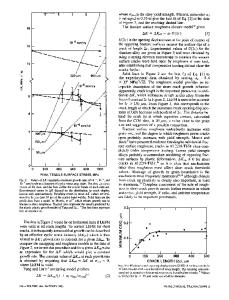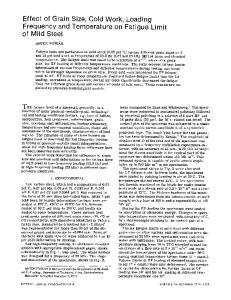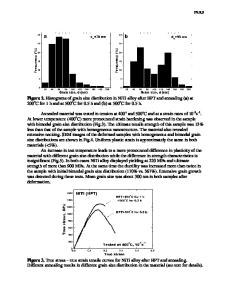The Effect of Grain Size on Fatigue Growth of Short Cracks
- PDF / 785,165 Bytes
- 9 Pages / 603.28 x 788 pts Page_size
- 26 Downloads / 280 Views
10-4 I.
I
I
I
I
I
I
I
1
I
INTRODUCTION
F A T I G U E propagation of short cracks is a stochastic process. Individual cracks grow at erratic rates determined by the alloy microstructure in their paths. Figure 1 illustrates such behavior for transgranular surface cracks in A1 7075-T6. Scatter in growth rate of a single crack is greatest at short lengths and is bounded by loci defined by the rate limits for many cracks. Frequently, it is useful to define an average growth rate (dashed line), dc/dN, of such an ensemble of cracks and relate it to stress intensity range, AK. For short cracks, dc/dN is not uniquely determined by AK, but is also a function of alternating stress amplitude, o'a, crack length, 2c, and prior load history. Numerous mechanisms apparently contribute to this failure of fracture mechanics.~-~2 Several of these incorporate grain size as an important parameter in the relationship of average dc/dN to AK, O'a, and 2c. In this paper the observation and modeling of such phenomena for A1 7075-T6 is reported. Growth rates were determined in AI 7075 that was prepared in two grain sizes. These data were obtained as a function of 2c and cro for both tension-tension and ful!y reversed loading. Correlations between average growth rate, cyclic stress amplitude, and alloy grain size are identified and attributed to the interruption of growth by grain boundaries, and for tension-tension loading to the fatigue induced development of a compressive residual stress on the surface. Both mechanisms are found to depend on alloy grain size.
II.
I
10-5
./".:
m
:..:: ". ..-.
/,"
!
E E Z 9 a
9
i
t~
"2 ~ ".~ [/
~ 9
9"
10 -6
[
CRACK GROWTH
EXPERIMENTAL PROCEDURE
A thermomechanical process for grain refinement was used to prepare materials in two grain sizes. 13A small block of A1 7075-T6 was rolled to achieve a 90 pct reduction in cross section, to a final thickness of 0.4 cm. Sections of this plate were solution treated and aged to produce grain sizes of 12 or 130/xm in the T6 condition. These are average dimensions measured at 45 deg to the rolling direction. To A. K. ZUREK, M. R. JAMES, and W. L. MORRIS are all Members of Technical Staff, Rockwell International Science Center, Thousand Oaks, CA 91360. Manuscript submitted June 15, 1982.
METALLURGICALTRANSACTIONS A
I0-7
I
I
I
I
0
AK(MPax/~) Fig. 1 - - T h e growth rate of a single short surface crack, shown here for 12/zm grain size AI 7075-T6, is erratic. The bounds of the rate limits for 15 short cracks define a scatter band representing the stochastic nature of short crack growth. The average growth rate (large data points, dashed line) is useful in defining relationships between growth rate and pertinent parameters. The error bars represent 70 pct confidence limits in the average value.
VOLUME 14A, AUGUST 1983-- 1697
eliminate residual surface stresses, fatigue specimens were machined from the center of each plate using progressively shallower cutting depths. Final thickness was approximately 0.16 cm. Values of yield strength for
Data Loading...











